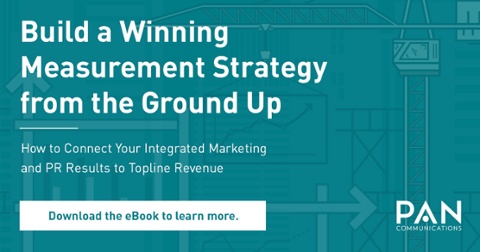The conversation around measurement in PR is often centered around how and what to measure, to accurately reflect the impact of PR as it relates to ROI and brand awareness. What’s often missing from this conversation is when we measure. It may seem intuitive to say, of course, we measure at the end of a campaign or quarter to determine effectiveness and success. While that can be helpful for executing future campaigns that may be similar in nature, most PR campaigns and initiatives are fairly unique from one another – with different objectives, goals and tactics.
First things first, determine what you will be measuring and how you are setting goals. An important part of this exercise, and of setting admirable yet achievable goals, is evaluating what has worked in the past. Have you run similar campaigns, and did you achieve those goals? If so, did the results have the impact your businesses needed, or do you need to create new goals that drive more impact? If you missed your goals, determine if you need to adjust them, or pivot your approach to achieving them.
Measure Early, Measure Often – and Adjust Accordingly
Once goals are set and a campaign kicks off, the best way to ensure success is to measure early, and measure often. Measuring at the end of a campaign provides no room for improvement or room to pivot if the campaign wasn’t successful. Even measuring halfway through a campaign can be too late, if your goals were aligned to a specific timeframe, but results at the halfway mark aren’t lining up. Instead of setting goals to be reached by the end of the campaign, consider setting up milestone goals, determining what goals should be achieved by when, throughout the campaign. If implementing this approach, set softer goals for earlier milestones, such as securing interest from two reporters within the first week of a campaign – instead of tying it to coverage secured at the outset of the campaign.
Let’s say you’re a retail technology company, and you kicked off a Black Friday media campaign to increase awareness of your platform’s benefits for retailers, capitalizing on the industry’s busy season. The official campaign runs for three months, kicking off six weeks before Black Friday and ending Dec. 31. If you’re waiting until halfway through the campaign to measure success and find that you’re behind where you need to be, you’ve shot yourself in the foot by already missing weeks’ worth of Black Friday-focused news stories leading up to the big day. Any changes that could be made to the campaign tactics or strategy, must now be executed in a much smaller timeframe, leaving your PR team to scramble for results.
Instead, measure within the first week, or week and a half of the campaign for the first milestone. It’s true that securing proactive media opportunities can take time, but taking a step back early can provide insight into what’s working or what’s not – to determine if adjustments need to be made early to meet future campaign milestones.
Now, if one of the campaign goals was 10 feature articles on Black Friday topics in retail tech publications, this doesn’t mean that you should have two pieces secured and published within that first week. Media opportunities can take time. What this does mean, is taking a look at traction and feedback – or lack thereof – within that first week. If the media are responding but saying that it’s not a fit for them, consider if you’re targeting the right reporters and publications for the story you want to tell. If you’re getting radio silence from media targets, reconsider if your messaging is coming across in the most compelling, newsworthy way. Or, maybe you’ve noticed that the media aren’t covering you, but they are covering your direct competitors – what assets do they have that you might be missing? It could be customers; data; or even product-specific messaging, when you took more of a thought leadership approach. Re-evaluate where you are in meeting your goals several times throughout the campaign, mapping to your milestone goals and adjusting as necessary. When goals are on target or better, hone in on why that is, and capitalize on what’s working so that you can replicate it elsewhere within the media campaign.
Bottom line – measure early, measure often. Throughout the campaign, analyze what’s working, what’s not, and identify how you can pivot your campaign tactics to reach your goals. In PR and across our clients’ industries, things are constantly changing – and that means our campaigns sometimes need adjusting, too. Measurement needs to happen throughout campaigns, giving brands the agility and insight to assess and adjust accordingly. When you measure could be the difference between achieving your goals, or missing them.
Interested in learning about integrated measurement? Check out, “Achieving Better Business Impact with the Right Integrated Marketing and PR Measurement.”
 Source:
Source: 
